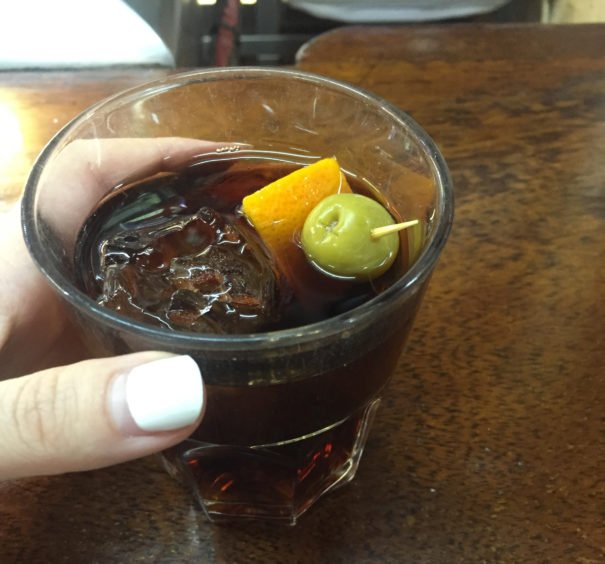
The Best Drinks, Like the Best People, Are Often a Little Hard to Like At First

The Best Drinks, Like the Best People, Are Often a Little Hard to Like At First
Vermut in Barcelona
It’s hard to avoid feeling like a tourist in Barcelona’s Barrio Gótico. According to the locals, you’re not in the Barrio Gótico at all, but actually in the Barri Gòtic, and unless you pick up some Catalan, your chances of passing as a local are slim.
If you’re lucky, as you wander down the centuries-old streets you’ll stumble across a brightly lit spot, its fluorescent lights shining anachronistically against the building’s old stones. The sign simply reads “Bar,” a word that acts as a beacon whether in Spanish, Catalan, or English. Step through the door, and no one glances up. Everyone is facing away from the bar, eyes glued to a television set broadcasting the soccer game that is taking place a few miles away at Camp Nou, Barcelona’s football stadium.
The bar offers a line-up of tapas, kept warm inside a glass-fronted counter that runs the length of the room. These are not the dainty, manicured version of tapas served in sleek, dimly lit restaurants, but honest fare for hungry laborers or late-night giggling drunks desperate to sober up over some fried food. Under the glowing lights of the warming unit sits a baseball-sized piece of fried bacallà, a large xoricets (chorizo) that could surely pack a wallop, and a bunyol d’albergina (eggplant fried with …something) that looks lethal whether you’re drunk or sober.
On the counter sits a ceramic crock with an oversized cork, and a handwritten label that reads vermut casero, one euro. I order some, and the bartender, formally dressed in a starched white shirt and black tie, nods and pulls out a glass from below the counter. He ladles a brick-red liqueur into the glass and garnishes it with an orange and an olive skewered together. He hands it to me with another nod and goes back to watching the game.
Vermut is a fortified wine, made by steeping botanicals in wine and then mixing in brandy or another high-proof spirit. There’s a dry version typically used in martinis, but it’s the sweet version that is favored in Spain, made from a white-wine base mixed with spices, such as cardamom, to give it its reddish color.
The first sip tastes like a Yankee Candle; overly spiced and reminiscent of the potpourri in a family restaurant’s wicker-lined bathroom. The second taste is floral and sweet like a sherry, with the brininess of the olive and acidity of the orange cutting through the sweetness. By the third drink, you’re hooked on the complex, herbaceous, clove-tinged fruitiness of the vermut.
While classic producers are still churning out barrels of the traditional sweet red vermouth marked either “basic,” or aged for a bit and labeled “reserva,” the next generation of vintners are innovating. New producers are experimenting with the old recipes, using different varietals of grapes as a base, aging them in large or small or red-wine barrels, or trying out biodynamic practices. Their vermut is subtle and complex and eminently drinkable.
This cup was not that. This was just an honest vermut casero, ladled from a crock into a dusky water glass. It wasn’t gracious or pretty, but it was pretty darn good.